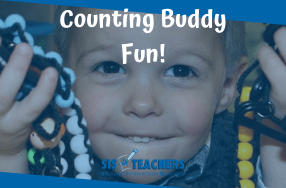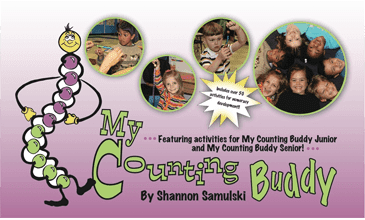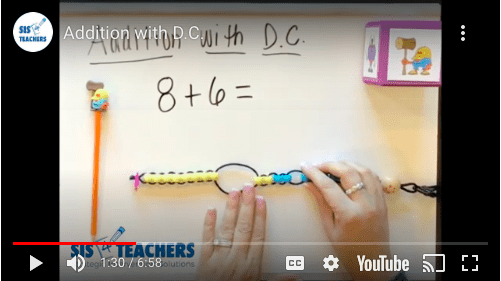Do you have a Counting Buddy Jr. or a Counting Buddy Sr. in your classroom? Ever wished you used it more? Get ready to explore the many ways this versatile little manipulative can be used, even outside of math!

I designed the Counting Buddy nine years ago as an organized way to have students use a math manipulative without getting out a ton of counters. I felt like I lost the mathematical concept I was trying to illustrate whenever students started playing with a bunch of counters – knocking them on the floor or making stacks instead of doing what I wanted them to do.
The Counting Buddy is a macrame beaded tool that is one of my favorites that we have in classrooms. I even have one on my golf bag for the times I’m really off on par! Counting Buddy Jr. is five beads of one color and five of another. The Counting Buddy Sr. has 10 of one color and 10 of another. Most teachers will put 30 Counting Buddy Jrs in their Math Salad Bar for Preschool and Kindergarten. First grade and second grade teachers use the Counting Buddy Sr.
The idea for the Counting Buddy came while I was on an airplane ride to Chicago for a presentation. I didn’t have any paper, and so I used the barf bag from the back of the seat in front of me and started drawing the idea for what it could look like. I knew I wanted it to be cute, friendly for kids, and that I wanted it to have the macrame beading to make it easy to use, but then I had to figure out all the different parts and see how I could make my doodling actually come to fruition. It’s funny to look back at this original design and see how we started, and then to look at what the Counting Buddy is today.
At the time, my cousin was doing a lot with bracelet-making so I asked her to make a few different prototypes. We ordered lots of different doll heads, and the Counting Buddy has definitely evolved over the years. I wish now that I had saved all the different types of heads, because as we look online, whether it’s at JoAnn Fabrics or on Etsy, or on Amazon, the different doll heads over time, go out of stock and I need them to have the right size hole drilled in them to move them to be big enough. Some of our heads have been larger doll bead heads that were different colors one time. we had a blue head and a pink and the yellow head, those are really cute. We ended up then having a little bit smaller of a head, but it was different ethnicities and so that was kind of fun to have for students just to see the doll heads resembling more of themselves. We have kept pretty consistent with our large rounded bead head with the smiley face on it, to kind of be the picture of the Counting Buddy.

The Counting Buddy has a plastic clip at the top, above the head, because I thought kids could clip it to either a notebook or their backpack and it would be a great way for them to be able to hang on to it. We looked all over and found the company, America’s Plastics in California, so we could get the clips as cheap as possible.
It took us a long time to figure out what was going to be the best lacing. We ended up using a black athletic lace because it had a nice smooth feel to it as the beads are moving on it in a macrame beaded fashion, they really slid nicely for students. Also, it didn’t fray. Now, we buy this lacing in bulk. We have a lacing company that will create seven grosses of lace at a time for us. Putting the tabs on the end of the shoelace is the most expensive part, so this company will just let the machine run all evening without cutting the lace or tabbing it, and we end up with large spools of lacing.
And then we ordered little bare feet to go at the bottom of the Counting Buddy, which are really hard to find. I ended up having to go and get them from China and have them sent to us. They’re actually charms that could go on a necklace like you might see in P.E. where students earn footprints for however many miles they’ve walked.
The hardest part of the Counting Buddy, however, is finding the larger pony beads. Pony beads are sold in the smaller version everywhere, but we needed 11 or 12 millimeters to be able to make the bead, big enough for a small hand to move in a macrame beaded fashion. Ironically, I have found most of the beads at bird shops or African American hair suppliers. We’ve worked with several different companies to try to get the beads in, and we just got some really pretty pastel colors and primary colors as well!
Now that we had these materials, meticulously sourced so we could keep the cost down as low as possible, we had to figure out how to actually make the Counting Buddies. I was presenting every day and had a family with small children, so there was no way I could add Counting Buddy Elf to my job title!
We ended up recruiting some high school girls that played on the basketball team, asking them if they wanted to make some extra money to sit around and make Counting Buddies while they watched TV. When the girls were done with a batch of Counting Buddies, they’d bring them over and we’d pay them. We joked that our neighbors probably thought we were drug lords – I mean, high school kids bring us brown paper bags crammed with stuff, and we paid them cash.
Honestly, though, it was one of the best factories we could come up with as we went. Now, Pat Carpenter, an aunt of ours that is just amazing, works with her husband to create them for me. Read more about her in this blog post here.
With all the different virtual conferences we’ve been doing, I must say this has been one item that we struggle to have in stock. I hope one day to be able to mass produce the Counting Buddy to get the cost down even lower and be able to get it out to more schools.
Out of the Box (NOT Math) Uses for the Counting Buddy
- As a fidget. I could present and I could sit in the class and move the macrame beads back and forth, and not really be destructive with my attention.
- Writing sentences. Early on, when kids are beginning to write, they really struggle with recording their thoughts onto paper in a way that says what they want it to say. When kids are writing, they can use the Counting Buddy to count how many words are in their sentence. “I went to the park. They could pull over one bead for “I”, another bead for “went”, another beat for “to”, another bead for “the” and another bead for park. Then, when the teacher asks how many words are in your sentence, you can respond confidently!
- Ear Spelling. A child can write down the word “went” and begin to sound out the word. They can pull a bead across for the /w/, another for the /n/ sound, and the last bead for the /t/.
- Phonemic Awareness. I can say “say say sit, say sit, say the sounds you hear,” and set a kid to pull over the beads to say the /s/ sound, the /i/ sound and the /t/ sound. Similar to elkonin boxes, this is a great mnemonic device to help kids associate the sound they’re hearing with the word.
- Playing with Sounds. Take the word “lip,” have kids sound out the word on the Counting Buddy, and then ask if they can change the last sound they heard to a /t/. That would be the word “lit.” The Counting Buddy is a great physical reminder of which sound they’re going to switch and what the new sound will be as they’re really working on understanding phonemic awareness.
Counting Buddy in Math
Of course, we use our Counting Buddy a whole lot in our numeracy talks as rekenreks. We clear all the beads to the right, over to Counting Buddy’s head, and then push beads to the left to have kids read the quantity.
The Counting Buddy Jr. is used in our yellow level of numeracy talks, our conservation to 10 series.We also use the Counting Buddy Sr. in the green level of our numeracy talks where we are talking about conservation to 20. If you’re part of our membership website, download all three levels for free, or you can get the freebie before you buy the product in our store.
There were so many uses for a Counting Buddy that ended up writing a book containing 50 activities!
Sometimes we just don’t have time for a book, though, so I also created a video tutorial that walks you through the basics of using a Counting Buddy and then demonstrates four activities using each level of Counting Buddy. There’s a free download for each level that you can use to help you remember some of these new ideas.
Visit the Counting Buddy Fun resource page for videos, downloads, and coloring pages!

Part-Part-Whole

One of my favorite activities with a Counting Buddy is to push all of one color beads towards the head and the other color towards the Counting Buddy’s feet, basically separating the colors on either end. We’re always talking about part-part-total with students, and this helps them visualize all the parts of a number. Let’s take seven, for example. Kids can pull over five of one color and two of another, meeting in the middle to display their amount. Then, you can ask to see the same number a different way, so a child might pull over four of one color and three of another. This activity would correspond well with number bonds, so kids can see those different parts of that number.
“I Wish I Had” is a fun game to play, where you can display an amount on the Counting Buddy (let’s say four), and the say “I wish I had seven.” Then the kids have to figure out how many more you would need to make the number you “wish you had,” which would be the missing addend.
Another of my favorite activities on the Counting Buddy Sr. is being able to help students really understand the idea of making 10. We clear the beads towards the Counting Buddy’s head, push eight beads down to the left, towards the feet, and then leave a little bit of space to add five more beads. You can see this idea in action in our D.C. video. In this activity, students can see that there are 10 of one color and 10 of another, so instead of putting eight in their head and counting on, one by one, to go up, we want kids to see what “making a 10” really means. Saying that phrase might not mean much to a student, but when they can see it happening on the Counting Buddy, it makes so much more sense. They can see that, as they’re adding on, the beads are the same color. It’s a lot easier for me to push these two beads up with the other eight because they’re all the same color. Be sure to bring in the correct language here – you want to decompose the five into two and three, bring that two in with the eight to make a 10.
Check out the video that we did on D.C. to show that, as well.
This is just the beginning – we’ll continue to do some more videos on the Counting Buddy to help you find different ways to use it in your classroom! In the meantime, check out our video and download your free activity cards to help you remember what you learned today!
Don’t have Counting Buddies yet? You can get a class set, which comes with a download of our book for free!







